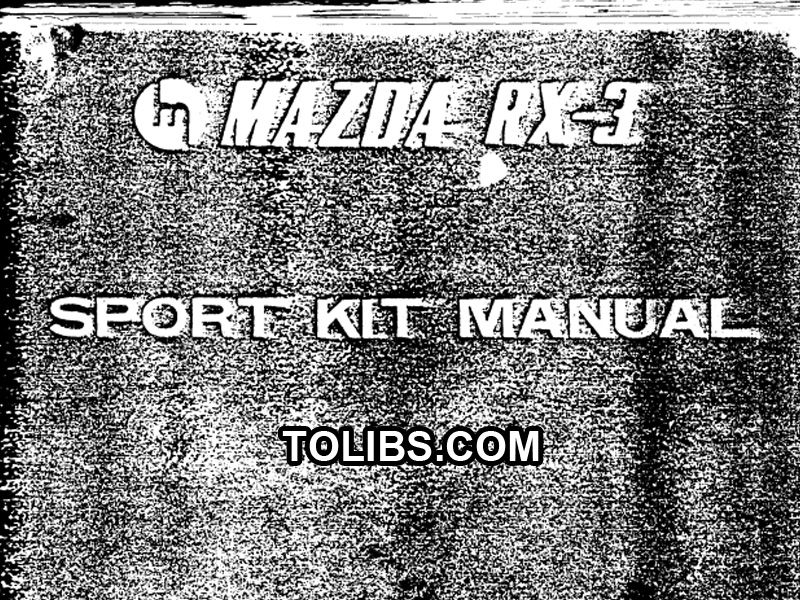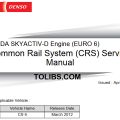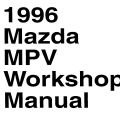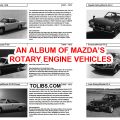Sports Kit Manual for Mazda Rx3 (70-73)

This RX-3 SPORT KIT MANUAL deals with machining, changes and assembling of all sport kits for the RX-3. Explanation is given on how to make the modifications required for higher performance in competition running. It is our hope that this manual will lead to births of excellent tune-up versions of this model.
| CHAPTER | Content | Page |
| CHAPTER 1 | COMPONENTS OF RX-3 SPORTS KIT | 1: 1-1: 2 |
| CHAPTER 2 | SPORTS KIT FOR ENGINE | 2 : 1-2: 2 |
| CHAPTER 3 | WORK PROCEDURE FOR ENGINE | 3:1-3:4 |
| CHAPTER 4 | SPORTS KIT FOR CHASSIS AND BODY | 4:1-4:4 |
| CHAPTER 5 | WORK PROCEDURE FOR CHASSIS AND BODY | 5:1 |
| CHAPTER 6 | SPORTS KIT FOR DRIVING SYSTEM | 6:1-6:2 |
| CHAPTER 7 | WORK PROCEDURE FOR DRIVING SYSTEM | 7: 1-7: 2 |
| CHAPTER 8 | CAR SPEED DIAGRAM | 8:1 |
- 1-A. ENGINE 1 : 1
- 1-A-1. Intake Kit Common for Stage-1,2 and 3
- 1-A-2. Exhaust Kit for Stage -2 and 3
- 1-A-3. Rotating Kat for Stage-3
- 1-A-4. Electric Kit for Stage-2 and 3 (Applicable to Stage-1, too)
- 1-A-5. Cooling Kit for Stage-2 and 3
- 1-B. CHASSIS AND BODY KIT
- 1-B-1. Suspension Kit Common for Stage-1,2 and 3
- 1-B-2. Brake Kit Common for Stage-1, 2 and 3
- 1-B-3. Steering Kit Common for Stage-1, 2 and 3
- 1-B-4. Body Optional Kit
- 1-C. DRIVING SYSTEM KIT
- 1-C-1. Driving System Kit Common for Stage-1, and 3 (4-Forward Speed T/Mission use)
- 1-C-2. Driving System Kit Common for Stage-1, and 3 (5-Forward Speed T/Mission use)
COMPONENTS OF RX-3 SPORTS KIT
1-A. ENGINE KIT
| Description | Part No. | Qty |
| Intake Manifold | 0870 73 200A | 1 |
| Gasket | 0870 78 205 | 1 |
| Gasket | 0822 78 229 | 4 |
| Carburettor | 0822 78 215 | 1 |
| Jet Set, Carburettor | 0870 78 215 | 1 |
| Fuel Pipe | 0822 78 211 | 1 |
| Supporter | 0822 78 220 | 2 |
| Bracket, Accel, Wire | 0870 78 203 | 1 |
| Nut | 99901 0800 | 8 |
| Plain Washer | 99952 0800 | 8 |
| Spring Washer | 99971 0800 | 8 |
| Air Cleaner | 0839 78 220 | 1 |
| Air Hom | 0839 78 230 | 2 |
| Nut | 99906 0500 | 6 |
| Spring Washer | 99971 0500 | 6 |
| Metering Oil tube | 0822 78 370 | 1 |
| Connector | 0822 78 384 | 1 |
| Plate | 0822 78 335 | 1 |
| Lever | 0822 78 386 | 1 |
| Vacuum Control Tube | 0822 78 447 | 1 |
| Vacuum Control Tube | 0822 78 448 | 2 |
| Pipe | 0844 18 590 | 1 |
SPORTS KIT FOR ENGINE
The spcrt kits for the RX-3 are broadly divided into three kinds of stage-1, stage-2 and stage-3, which are freely selectable in accordance to the notorist's driving skill and preferences. For the driving system, chassis and body, too, various beef-up packages are available for selection to suit the output of the engine.
2-A. CLASSIFICATION
2-A-1. Stage-1 Kit
Tune-up by changing parts of the intake system.
2-A-2. Stage-2 Kit
Tune-up by changing pars of the intake and exhaust systems.
2-A-3. Stage-3 Kit
Full tune-up for speed racing.
2-B. EXPLANATION OF ENGINE KIT PARTS
2-3-1. Intake System
- Carburettor: The carburettor is a NIPPON KIKAI CO.’s downdraft twin choke type, excellent performance of which has been proved in races in the past. This carburettor is featured by its sensitive response to throttle opening, no inertia-caused change in fuel level by virtue f of the cemrally-iocated float chamber common to I two barrels, and ease of jet replacing. Jets are ! available in several kinds as different jets might be required depending on the extent of engine tuning.
- Air cleaner: Air induction with small resistance and good filtration is assured by a polyurethane foam air cleaner which is disposed sideways and sucks air throughout the circumference.
- Intake manifold and carburettor supporter: The intake manifold has been modified to permit mounting the down-draft twin choke carburettor. The carburettor supporter has been established to prevent ruffling of fuel level in the float chamber.
2-3-2. Exhaust System
(1) Exhaust manifold and pipe
Small exhaust resistance is ensured be stainless steel, straight-through independent pipes merged into a common pipe. Also, special exhaust manifolding has been established.
2-3-3. Housing
(1) Front, intermediate and rear housing The intake port of the standard housings are additionally machined for improved intake efficiency.
(2) Rotor housing
The exhaust port is machined to improve exhaust efficiency. This machining is done at Toyo Kogyo as special machining techniques are required.
2-3-4, Rotating System
- Rotor assembly
- The rotor is of the same material and configuration as the standard one. The special design made is one for preventing the internal gear from slipping out at high engine speeds (spring pin and ring lock).
- Flywheel and balance weight An integral ring gear with reduced inertia moment and reduced weight is used for improved acceleration response.
- Needle bearing Thrust needle bearing of tough material is used as it is subjected to greater force because of increased engine output coupled with frequent and harsh clutch engagements.
- Ecentric shaft The jet-through-bearing system is used to ensure adequate rotor cooling under high-rev. high-load conditions.
- Rotor bearing Rotor bearing of different material is used to enstife increased durability under h;gh-rev, high-load condihoru. A hole for rotor voiding is provided.
2-8-5. Seals
- Apex seal: The taper-cut type seal so designed that combustion gas pressure acting on the seal bottom can be utilized more effectively has been adopted to ensure closer contact with the rotor housing wall.
- Oil Seal: To ensure improved sealing efficiency at high-revs, the oil seal with a larger lip angle than the standard one is used.
- Oil Seal Spring: Increased oil seal efficiency at high-speeds is ensured by using a spring having higher set load.
2-B-6. Lubricating System
- Oil pump: Lubrication requirements of the sliding parts are much severer at high engine speeds, as are rotor. cooling requirements. Sufficient supply of lubricant is required to ensure durability against high-rev's and liighload. So the standard oil pump is machined to permit increased supply of lubricant.
- Oil pressure regulator: The oil pressure must be raised to give adequate lubrication under high-rev, high-load condition. So the modified unit has 6kg/cm' (85 lb/in2) pressure as against the standard unit’s 5 kg/cm2 (71 lb/in2) the rise in pressure being provided by altered spring and plug.
- Oil cooler: As oil temperature rises under high-rev, high-load condition, an oil cooler with increased cooling capacity is used.
- Oil hose: The oil hose is different in shape with higher pressure resistance and strength to suit the modified oil cooler.
- Oil metering pump: The pump body is of the standard unit. This is modified by discontinuing the throttle linking and mounting a fixed feed plate. It has only one discharge orifice with a special connector as the modified carburettor requires just one. Note: The control lever should be set to the full open position for competition running, and at the hole one step lower for wearing in and other light load operation.
- Oil filler pipe: A larger-diameter gas passage is provided to cope with blow-by gas and overflowing oil. While it is possible to additionally machine the standard filler pipe, the special unit has been adopted to ensure proper ventilation.
- Engine oil: Single grade SAE 30 - 40, SHELL and MOBIL products. LOCAL-MOLY or LOCAL-A.S.O. in the quantity of 7% of engine oil is added.
2-8-7. Cooling System
- Radiator: A radiator having increased radiating capacity is used for improved cooling under high-rev, high-load conditions.
- Water hose: A water hose shaped to suit the special radiator is used.
- Cooling fan and spacer: A polypropylene fan with six 3C0 mm (11.81 in) diablades is directly connected tor improved cooling effect.
- Fan belt: A Fan belt with increased strength is used to ensure satisfactory operation at high-revs.
- Water pump: Remove the thermostat from the standard unit and plug up the by pass to increase cooling efficiency.
2-8-8. Electrical System
- Alternator pulley: A puiley having a larger outer diameter than the standard one is used so that there will be no unnecessary rise of alternator revolution at high engine speeds.
- Ignition coil: An ignition coil with an external resister is used to make sure that there will be no secondary voltage drop at high-revs and powerful sparks will be obtained.
- Distributor: Special parts including rotor, arm supporter and cam felt are used on the standard body to prevent rotor floating and point arm jumping at high-revs and to assure accurate spark timing and powerful sparks.
- Spark plug: Three spark plugs varying in heat valve are available to permit selective use depending on the kind of race, the class of sport kit and other conditions.
- Fuel pump: A fuel pump with an increased discharging capacity is used as more fuel is required under high-speed, high-load conditions than in the case of the standard car.
2-C. MACHINING AND ATTACHING PROCEDURE
Machining of Intake Port
- Clean the intake port of each housing with paint thinner or ketone.
- Assemble three side housings and two rotor houssings, and tighten with three tension bolts.
Note:
- Remove the eccentric shatt and rotor betore assembling.
- Insert the tubular dowel properly.
- Smear blue petrolatum over the ports on the side where the intake pipes are to be attached. Then mount the modification gasket and mark lines.
- Disassemble she housings.
- Smear blue petrolatum at the ports in the sliding surfaces of the front housing, intermediate housing and rear housing, fix the jig (See Fig. 2-9) with the tubular dowel, and mark lines.
- Turn the jig over and mark lines for the auxiliary port centerline and drill centerline. (7) Punch the auxiliary port center mark.
- When the four faces of the housings have been marked, drill the holes, on a drilling machine. Note: When machining, make sure to remove studs, bolts and stationary gear.
- Perform the drilling operation Drilling the auxiliary port according to the following procedures:
- To prevent the flat sliding face from being scratched mask with tape, etc. all the surface except the machining area
- Use a drill ot 5.5 ~ 5.8 mm (0.22 ~ 0.23 in) {width of auxiliary port: 6 mm (0.24 in) }
- As to the front and rear side housings, see thatholes No. 1 ~ 5 are drilled through hole No. 6 is drilled to the depth of under 8 mm (0.31 in) and hole No. 7 to the depth of under 3 mm (0.12 in).
- As to the intermediate housing, see that holes No. 1 ~ 5 are drilled through, hole No. 6 is drilled to the depth of under 5 mm (0.20 in) and hole No. 7 to the depth of under 3 mm (0.12 in). (See Fig. 2-12) Mote: Take special attention so that drilling be not done beyond lines. Make sure that holes No. 6 ~ 7 are drilled to specified depths, for drilling through will cause the holes to be connected with the water jacket, resulting in water leak into the combustion chamber.
- The port is cut in the following procedure:
- Use a rbtary bar 6 mm (0.24 in) or under across.
- The target cutting angle for the auxiliary port closing side is 45 deg. for both front and rear housings and 30 deg. for the intermediate housing.
Note:
- a. Carefully cut by following the marked line,
- b. Firmly hold the hand cutter and take care not to scratch other sliding faces.
2- C-2. Machining of Oil Pump Body
- 1) Clean with paint thinner or ketone the oil pump installing side of the front housing, and apply blue petrolatum.
- 2) Attach the oil pump machining jig with bolts and mark the machining line.
- 3) Enlarge tiie port using a hand cutter (rotary bar 5 mm (0.20 in) dial. Smoothly cut each corner of the oil passage to as large radius as possible. (See Fig.2-15)
Note: Any erroneous cutting will necessitate replacing the side housing, so use extra care in machining.












